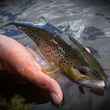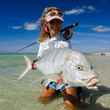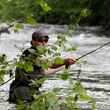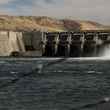Fishing tight, low, skinny water can be simultaneously frustrating and rewarding. And fishing these tiny creeks—most of which are so small anglers step over them without a second thought—often feels like more work than it’s worth. Whether because of fighting brush and losing flies, or dealing with impossibly spooky fish, it’s perhaps unsurprising that many anglers skip over this kind of water.
Yet for every frustrating, brush-choked creek that’s a nightmare to fish, there’s one like my secret cutthroat stream. This stream tumbles for three miles down a steep canyon, and is overgrown for most of its length. On the stretches where it’s open enough to cast, the water is so low and clear that you spend the day fishing from your knees. But it’s one of the few places I’ve found where you can realistically catch 100 fish in a single day. The cutthroat also happen to some of the prettiest I’ve caught anywhere, and they’ll take any well-presented dry fly. Those sort of benefits, by my accounting, easily outweigh the burden of losing flies and fighting through brush.
But despite its potential rewards, tight, low, skinny water can sometimes be more challenging than even a technical tailwater. This type of fishing requires a unique set of skills to tackle successfully. Thankfully, I’ve had the opportunity to develop that skillset over a lifetime spent fishing these types of creeks. Here are some guidelines.
Check the temps
On these streams, it should go without saying that you need to pay attention to water temperatures before fishing. If the water is 65 degrees or warmer, then you should find somewhere else to fish. As temperatures climb past 65, the amount of oxygen available in the water decreases—and trout need oxygen just as badly as us.
Rods and reels
The number-one issue for most anglers on tight, low, skinny water is their gear. Yes, your 9’ 5wt is a do-it-all rod for most situations. But tight creeks and five-inch fish aren’t most situations. That’s like taking a .338 Lapua rabbit hunting. You’ll either miss the rabbit entirely or blow it to smithereens.
I have a bevy of ultralight rods just for this purpose, but you don’t need a 5’9” 1wt to be effective on tight water. If you have a 7’ or 7’6” 3 or 4wt, you’ll be in business. I’d err on the side of a 3wt, because it’ll give you a softer presentation than a 4wt in most cases.
With such a light rod, you don’t need a reel with bonefish-stopping power. A click-and-pawl reel is just fine, since all the reel does in these situations is hold line. I’ve yet to encounter a fish so big on water two feet wide or narrower that demanded any kind of drag.
Finally, I’d suggest that your rod is one with a stiff butt and midsection, but a flexible tip. You’ll end up using the tip to cast in a lot of tight situations, and rods that are entirely fast or slow tend to land your flies in the trees more often.
Leader and tippet
I like a 7’6” 4 or 5x fluorocarbon leader for tight water. Shorter leaders are easier to control, which should mean you’ll lose fewer flies.
A heavier, shorter leader also casts better if you have little or no fly line out the tip of your rod. This is what I refer to as “casting off the tip”—when you’re just moving the rod enough that the tip flexes and throws leader out a few feet. Think of it as a more active form of dapping, if that helps you visualize.
If you’re on low, skinny water that’s so clear the fish seem to spook when you’re still a mile away, then it’s time to get creative.
In this situation, I like a longer leader—9 feet to start, and not bigger than 5x. Then I’ll add a few more feet of tippet and eventually taper down to 7x. The tippet needs to either be fluorocarbon, or if you want to use mono, Stroft is the brand I use. Stroft is German-made tippet, so it’s not coming out of the same Japanese factories where RIO, SA, Orvis, and everyone else makes their tippet. Stroft is also a more subtle blue-gray color that blends into the water well, without scaring fish, or sinking like fluorocarbon does.
I’ve used Stroft on big flat water in Oregon, where the browns rise to size 28 parachute midges, with great results. They even make tippet in half sizes, and 6.5x is my favorite for addressing low, skinny water.
Now, if your skinny water is also covered in tight brush, and you don’t have room to cast an 11-foot leader, then you have a few options.
Either way, I’d start out with a short section of 3x leader. From there, you can blood knot tippet on in 12-inch sections until you get to 6 or 7x. Or, you can tie on a tippet ring and immediately go to 7x off the ring.
I’ve come to prefer the tippet ring approach, because it’s far enough away from where your fly lands—and tippet rings are generally small enough—that it doesn’t make an undue disturbance on the water when it lands. It also allows for a lot quicker setup, and you don’t have to worry about as many knots failing.
Working the water
When I started fly fishing, one of the biggest mistakes I made was that I never effectively covered water. The way my dad put it, I skipped good water for the best water, and subsequently ruined both.
With low, skinny, tight water, it’s important to methodically work your way through it. Remember that fish tend to hold either in the riffles, or directly below them. In pools, fish the tailout first, then work your way to the head.
Dap your flies behind, to the sides, and in front of every rock. Do so from a high vantage point, but stay low and hidden enough that your silhouette won’t spook the fish. Get a few good drifts past every undercut bank you can.
On bigger rivers, this methodical approach sometimes isn’t practical. On water that’s two or three feet wide, you can hit all of the aforementioned spots in about five minutes.
Skipping water, though, and immediately casting to a seam at the head of a pool, is a surefire way to ruin a lot of good water, and subsequently, all the rest.
Stay soft and low
As you fish small water, it’s important to keep in mind that the only way you’ll be successful is by committing to keep your casts soft and subtle. Additionally, you need that same commitment to stay low, and avoid making a threatening silhouette. I’ve scared more fish in low, clear water by standing up too high, than I have with any errant casts (of which there have been plenty).
Keeping your casts soft is a technique you learn only through trial and error. I’ve fished water like this often enough that I know what I need to do in order for my casts to land softly. With the rods I fish, I’ve found a slight movement of my wrist is all I need. My arm and shoulder hardly move.
Your process might be completely different. The only way to tell is to get out there and do it.
Fly selection
I saved this for last because fly selection is really the least important factor in success on low, skinny water. Obviously, you can’t throw just anything and expect success. I largely stick to natural patterns with earthy colors—elk hair caddis, blue-winged olives, and zebra midges.
Unless there’s a hatch, or you see fish keyed in on emergers or spent-wings, there’s no reason to get fancy. A size 14 or 16 elk hair caddis, with a size 18 zebra midge dropper, is all the fly selection you need.
Now, I know I said this at the outset, but I promise that low, skinny, and clear water isn’t as much of a pain as you think. The fish you find while out on this type of water often redeem the effort and lost flies. At the very least, remember that you’re out fishing, instead of doing something else.































Comments
Jim Parks replied on Permalink
One bit of advice to catching "impossibly spooky" trout is to dress to blend. Rule #1 to that is NOT wearing a white hat. It's the simple details that can make or break catching wild, spooky trout in shallow, crystal clear water.
Craig replied on Permalink
I fish small streams almost exclusively (in the Northeast). This article is dead on for northern NY with the possible exception of hammering the cut banks. We have few cut banks and no cutthroats, so I find them less productive.
Pages